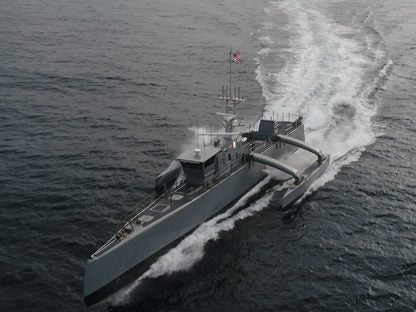
The US Department of Defence is looking to Unmanned Surface Vessels (USVs) to transport equipment and cargo.
The “Sea Train” programme or Improved Navy Lighterage System (INLS) is comprised of powered and unpowered platforms that can be assembled from different modules to complete a variety of missions under the direction of the US Navy and the Defence Advanced Research Projects Agency. (DARPA)
In documents, DARPA said: “The Sea Train programme seeks to enable extended transoceanic transit and long‐range naval operations by exploiting the efficiencies of a system of connected vessels (Sea Train). The Sea Train programme will demonstrate long‐range deployment capabilities for a distributed fleet of tactical unmanned surface vessels (USVs).”
The programme aims to overcome the range limitations of medium unmanned surface vessels (MUSVs and will operate by either physically connecting vessels or by sailing in collaborative formations, according to DARPA.
DARPA programme manager Andrew Nuss told The Times that the vessels would look like existing ships but would be able to complete “independent long-duration deployments” without having to interact with human-operated vessels or ports.
DARPA is today holding a Proposers Day to provide further information on the project to potential developers ahead of a planned agency announcement.
The agency’s registration page for the proposer day gives more details on the project adding: “DARPA will develop and demonstrate approaches to overcome the range limitations inherent to medium unmanned surface vessels (MUSVs) by exploiting wave‐making resistance reductions.
“DARPA envisions sea trains formed by physically connecting vessels with various degrees of freedom between the vessels, or vessels sailing in collaborative formations at various distances between the vessels.”
The US is investing in the development and research of unmanned vessels as part of its push to a 355 ship navy by 2030. USVs enable ships to be at sea for longer while also being cheaper as they do not need to house crew.
Under the agreed National Defence Authorisation Act for 2020, the US Navy will receive funding for the production of number of USVs including one large unmanned surface vessel (LUSV) and two medium unmanned surface vessels (MUSV).
The majority of the tasks USVs will fulfil are known as 3D missions, meaning they are dull, dirty or dangerous.
Earlier this year in August the US Navy unveiled plans for a 10-ship fleet of corvette-sized large unmanned surface vessels (LUSV) to be built over the next five years as part of its wider push for more unmanned vehicles.



